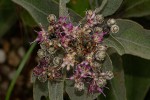| Home | > | List of cultivated families | > | Asteraceae | > | Vernonia |
8751.000 Vernonia
CYANTHILLIUM Blume
GYMNANTHEMUM Cass.
HILLIARDIELLA H. Rob.
LINZIA Sch. Bip. ex Walp.
ORBIVESTUS H. Rob.
POLYDORA Fenzl
VERNONIASTRUM H. Rob.
Herman, P.P.J. & Swelankomo, N. (2011) Vernonia (Tribe Vernonieae) and related genera in Southern Africa: updates and corrections Bothalia 41(1) 176-178
Wild, H. (1978) The Compositae of the Flora Zambesiaca area. 8. Vernonieae (Vernonia). Kirkia 11(1) 31-127
Description of the genus
Annual or perennial herbs (often with annual stems from woody rootstocks), small to large shrubs, woody scramblers or small trees. Leaves alternate, simple. Capitula homogamous, discoid; florets normally bisexual and fertile. Phyllaries free in 2-many series, imbricate. Corolla various shades of purple, blue, or creamy-white, regularly 5-lobed. Pappus 2-seriate with an outer short whorl of scales or setae and an inner whorl of longer setae. Derivation of name: Named after William Vernon, English botanist of the late 17th century. Worldwide: c. 1,000 species in warm and tropical regions of the Old World and America Caprivi: 10 cultivated taxa. The larvae of the following species of insect eat species of this genus:
|
 |
Links to cultivated taxa View: living plant images - herbarium specimen images - all images for this genus
| Species | Content |
| congolensis De Wild. & Muschl. | |
| griseopapposa G.V.Pope | |
| guineensis Benth. | |
| ischnophylla Muschl. | |
| melanocoma C.Jeffrey | |
| miombicola Wild | |
| praecox Welw. ex O.Hoffm. | |
| schweinfurthii Oliv. & Hiern | |
| sengana S.Moore | |
| turbinella S.Moore | Description, Image |
Other sources of information about Vernonia:
Our websites:
Flora of Botswana: VernoniaFlora of Caprivi: Vernonia
Flora of Malawi: Vernonia
Flora of Mozambique: Vernonia
Flora of Zambia: Vernonia
Flora of Zimbabwe: Vernonia
External websites:
African Plants: A Photo Guide (Senckenberg): VernoniaBHL (Biodiversity Heritage Library): Vernonia
EOL (Encyclopedia of Life): Vernonia
GBIF (Global Biodiversity Information Facility): Vernonia
Google: Web - Images - Scholar
iNaturalist: Vernonia
IPNI (International Plant Names Index): Vernonia
JSTOR Plant Science: Vernonia
Mansfeld World Database of Agricultural and Horticultural Crops: Vernonia
Plants of the World Online: Vernonia
Tropicos: Vernonia
Wikipedia: Vernonia
| Home | > | List of cultivated families | > | Asteraceae | > | Vernonia |